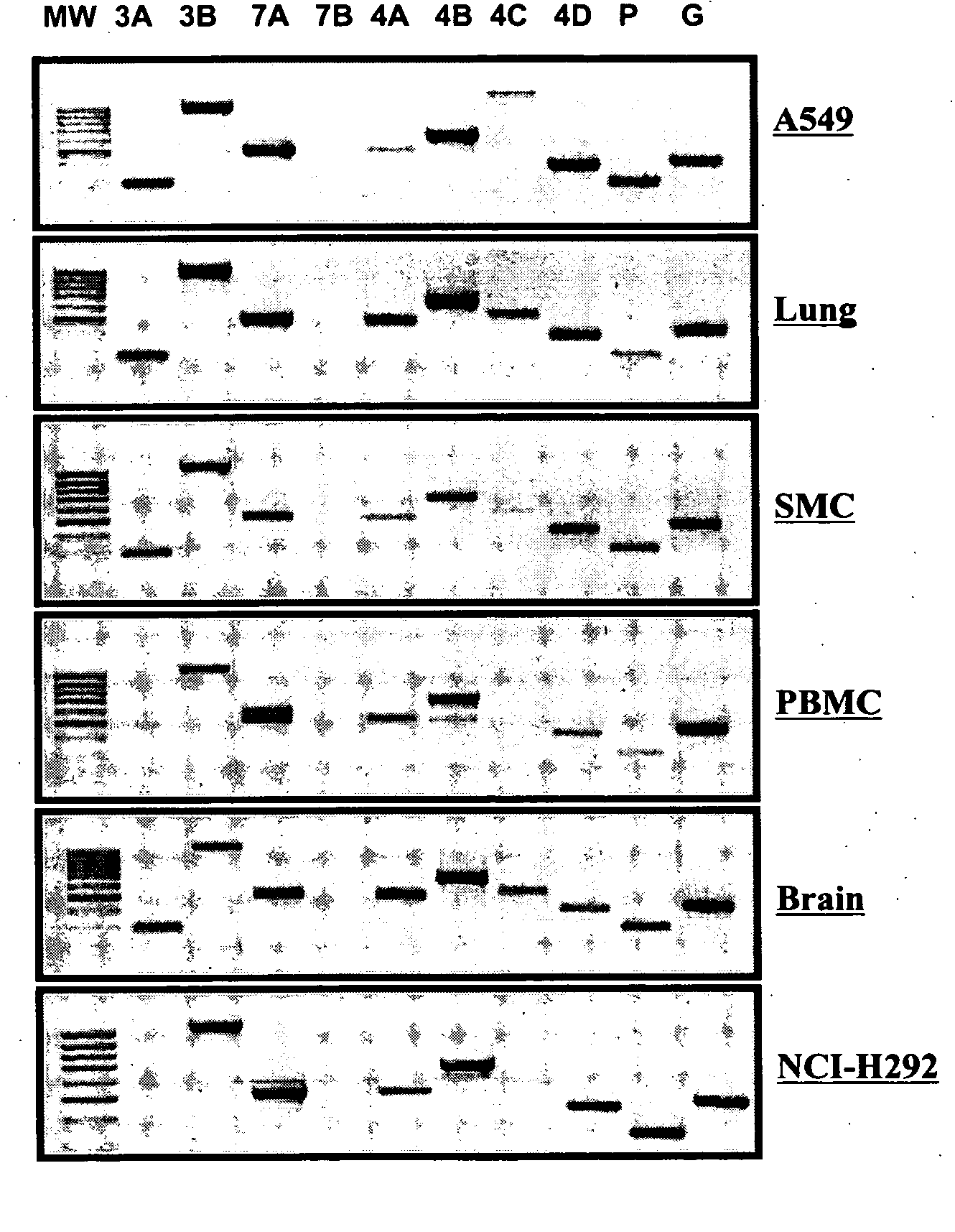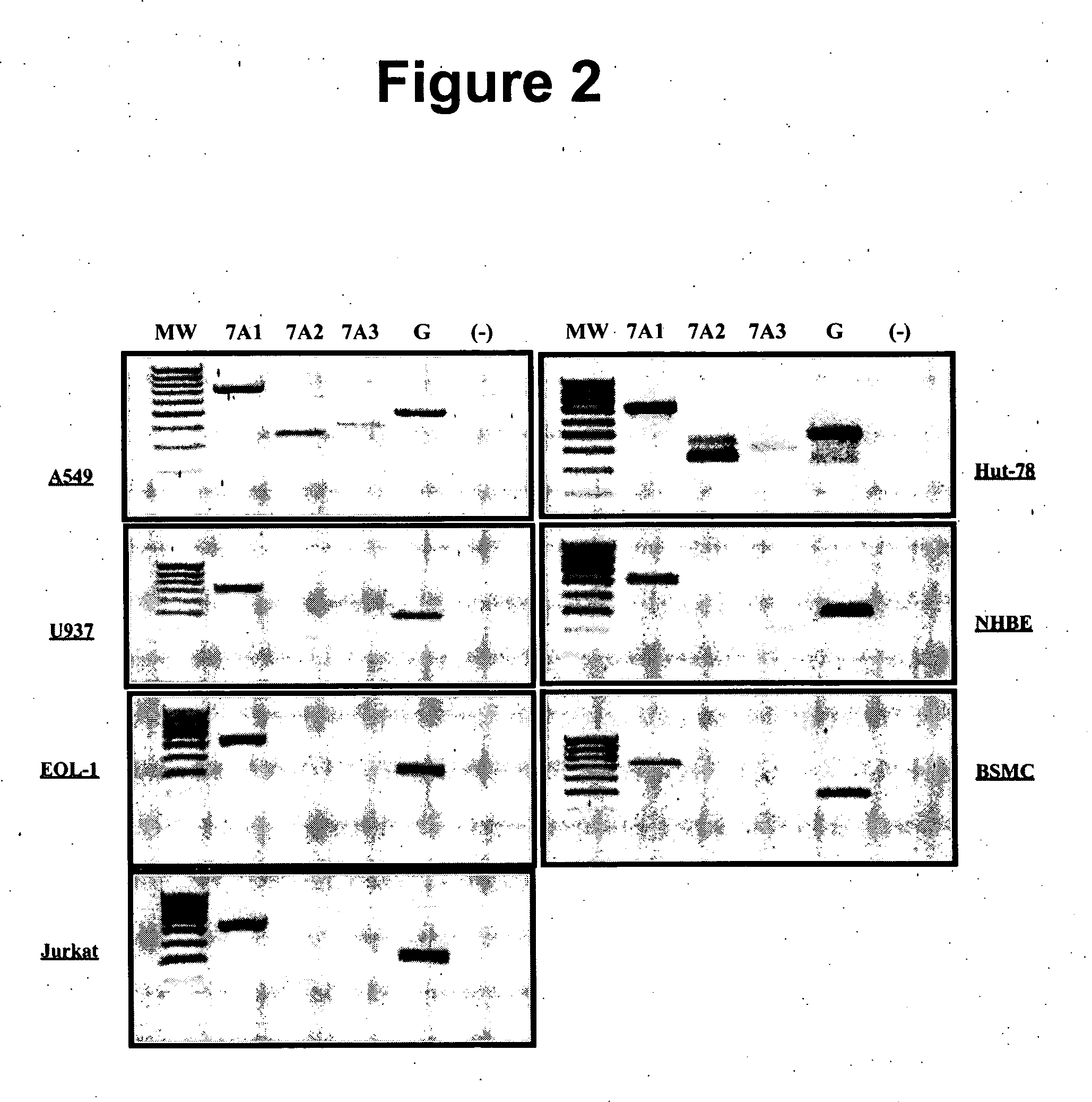Oligonucleotide compositions and methods for treating disease including inflammatory conditions
a technology of oligonucleotide compositions and compositions, applied in the direction of antibacterial agents, peptide/protein ingredients, immunological disorders, etc., can solve the problems of reducing the activity of pde enzymes, and affecting the effect of inflammatory conditions
- Summary
- Abstract
- Description
- Claims
- Application Information
AI Technical Summary
Benefits of technology
Problems solved by technology
Method used
Image
Examples
example 1
[0168] This example relates to PDE Isotype cell and tissue distribution. Inflammatory respiratory diseases are characterized by an interaction between inflammatory cells (macrophages, lymphocytes, neutrophils and eosinophils) and tissue cells (mostly epithelial cells and smooth muscle cells). mRNA expression of the isotypes of PDE 3 (PDE3A and B), PDE 7 (PDE7A and B) and of PDE 4 (PDE4A, B, C, and D) in different cells and tissue was assessed. A summary of the primers used for every PDE isotype can be found in Table 2a. The cells that were chosen were A549 (epithelial cell from an adenocarcinoma of the lung), and NCl-H292 (mucoepidermoid pulmonary carcinoma). Expression in primary human cells was assessed in BSMC (Human bronchial smooth muscle cells) and PBMC (Peripheral blood mononuclear cells). Normal human lung was also used to characterize the expression of PDEs. Finally, normal human brain was included as a control, since most PDEs are expressed in this tissue. As can be seen i...
example 2
[0170] This example relates to effective antisense oligonucleotides against PDE7A. Several antisense oligonucleotides against PDE7A mRNA were designed and assessed for their efficacy in the cells that express PDE7A. Table 1a includes a list of the sequences that were used. All the experiments were performed with increasing concentrations of the oligonucleotides and efficacy was assessed by comparing the ratio of PDE7A mRNA density over GAPDH density in the treated cells to that of the untreated cells.
[0171] It is to be noted in FIG. 3 that Top-1702 (Seq. ID No.3), Top-1706 (Seq. ID No.7), Top-1703 (Seq. ID No.4), Top-1701, (Seq. ID No.2), and Top-1707 (Seq. ID No.8), were found effective at inhibiting PDE7A mRNA expression in Eol-1 cells. In addition Top-1702 (Seq. ID No.3), Top-1703 (Seq. ID No.4), Top-1706 (Seq. ID No.7), and Top-1707 (Seq. ID No.8), inhibited PDE7A mRNA in U937 cells. In FIG. 4, several PDE7A antisense oligonucleotides displayed more than 60% inhibition of PDE7A...
example 3
[0173] This example relates to effective antisense oligonucleotides against PDE3A and PDE3B. A set of antisense oligonucleotides were designed and tested for their ability to decrease mRNA in several cell types. Table 1b-c includes a list of the sequences that were used.
[0174] Several antisense oligonucleotides were found to be effective at reducing PDE3A mRNA level in A549 cells and / or in U937 cells including Top-1301 (Seq. ID No.35), Top-1302 (Seq. ID No.36), Top-1303 (Seq. ID No.37), Top-1307 (Seq. ID No.41), Top-1308 (Seq. ID No.42), TOP 1309 (Seq. ID No.43), Top-1311 (Seq. ID No.45) and Top-1312 (Seq. ID No. 46, although less effective) as shown in FIG. 6, Table 4a (above) and 4b (below). In primary bronchial smooth muscle cells the same antisense oligonucleotides were also effective at decreasing PDE3A mRNA expression as shown in FIG. 7.
[0175] Experiments performed with PBMC using the PDE3B showed that several antisenses were effective at blocking specifically the PDE3B mRNA...
PUM
| Property | Measurement | Unit |
|---|---|---|
| Fraction | aaaaa | aaaaa |
| Fraction | aaaaa | aaaaa |
| Concentration | aaaaa | aaaaa |
Abstract
Description
Claims
Application Information
 Login to View More
Login to View More - R&D
- Intellectual Property
- Life Sciences
- Materials
- Tech Scout
- Unparalleled Data Quality
- Higher Quality Content
- 60% Fewer Hallucinations
Browse by: Latest US Patents, China's latest patents, Technical Efficacy Thesaurus, Application Domain, Technology Topic, Popular Technical Reports.
© 2025 PatSnap. All rights reserved.Legal|Privacy policy|Modern Slavery Act Transparency Statement|Sitemap|About US| Contact US: help@patsnap.com



